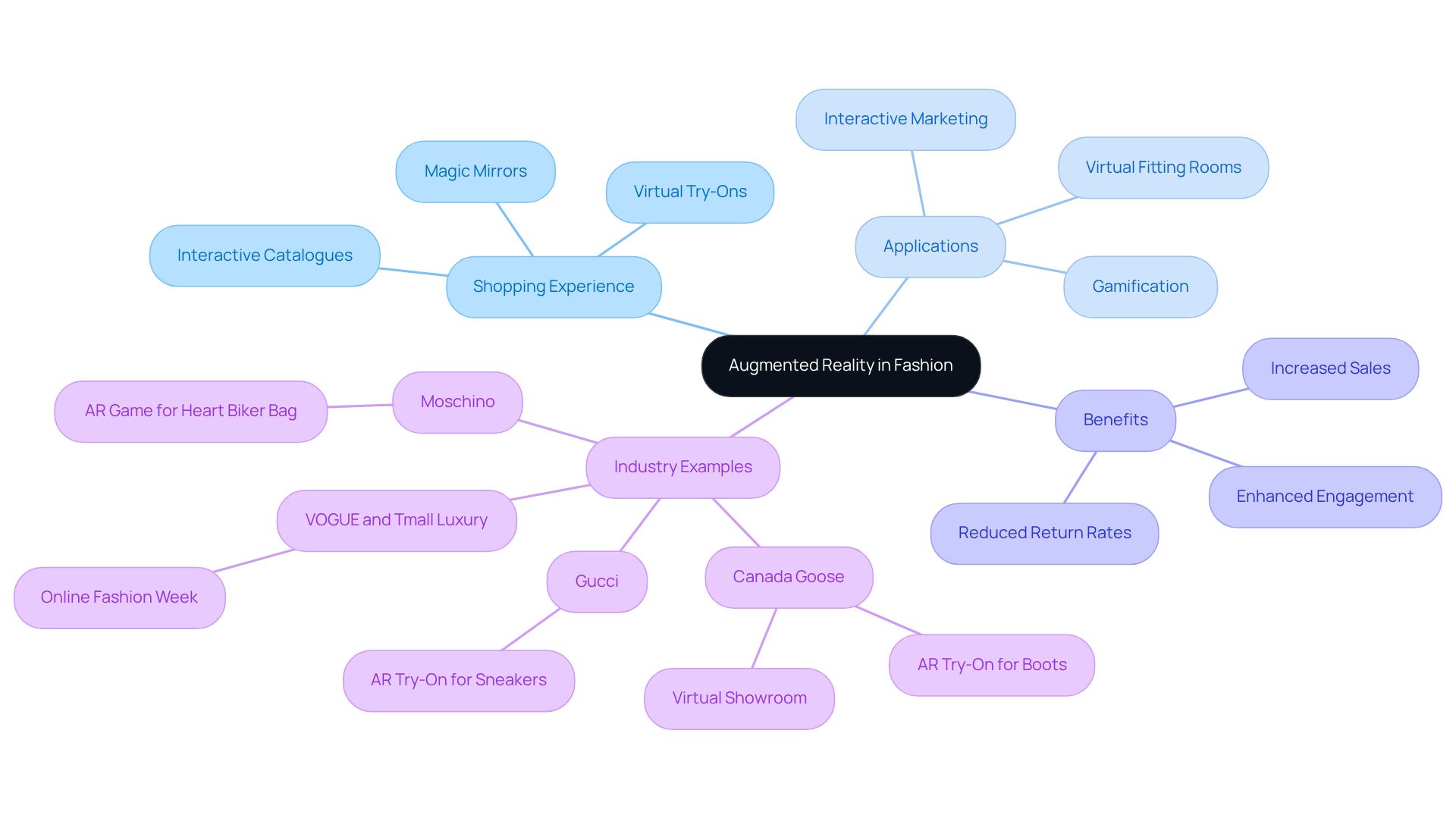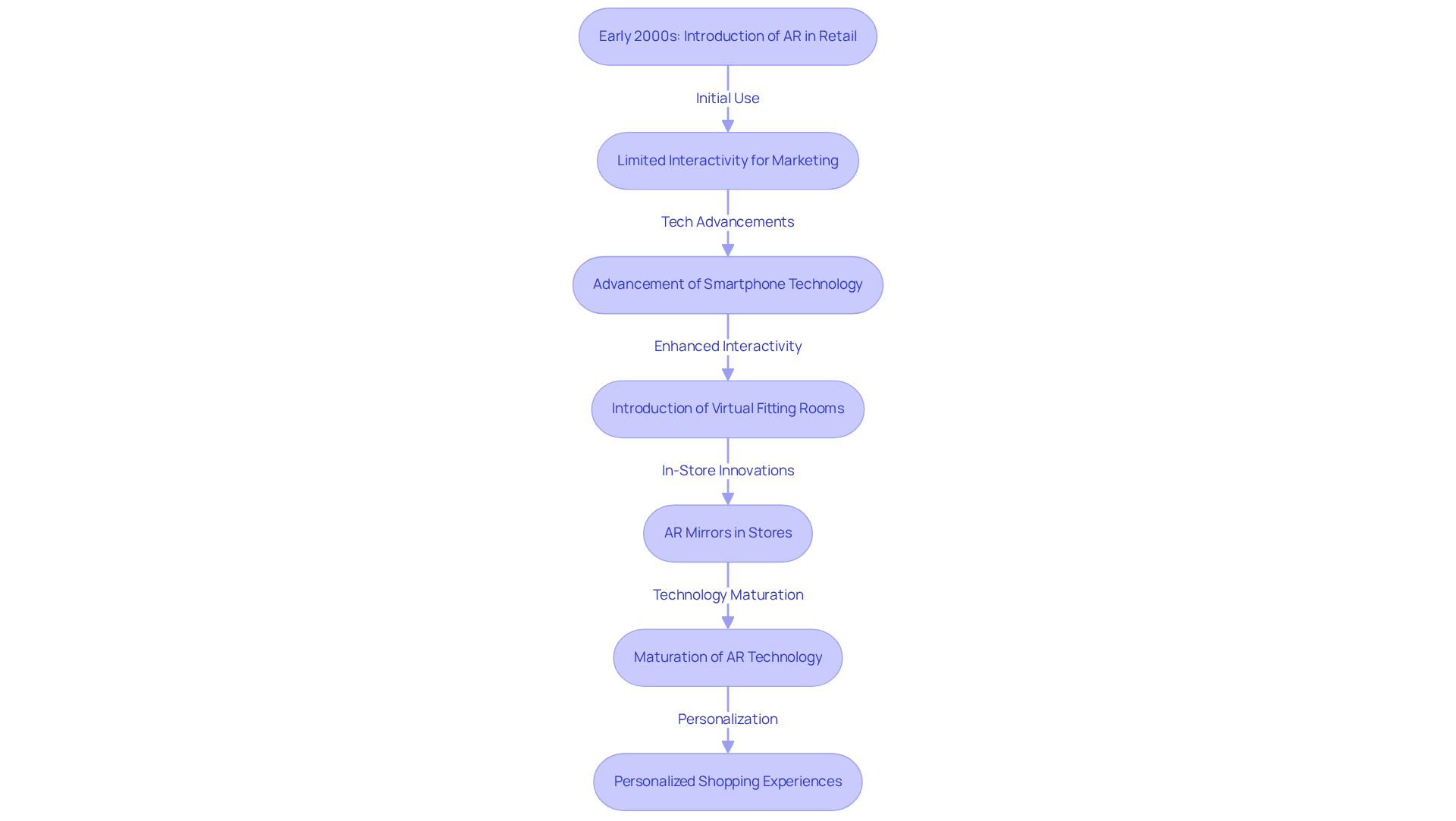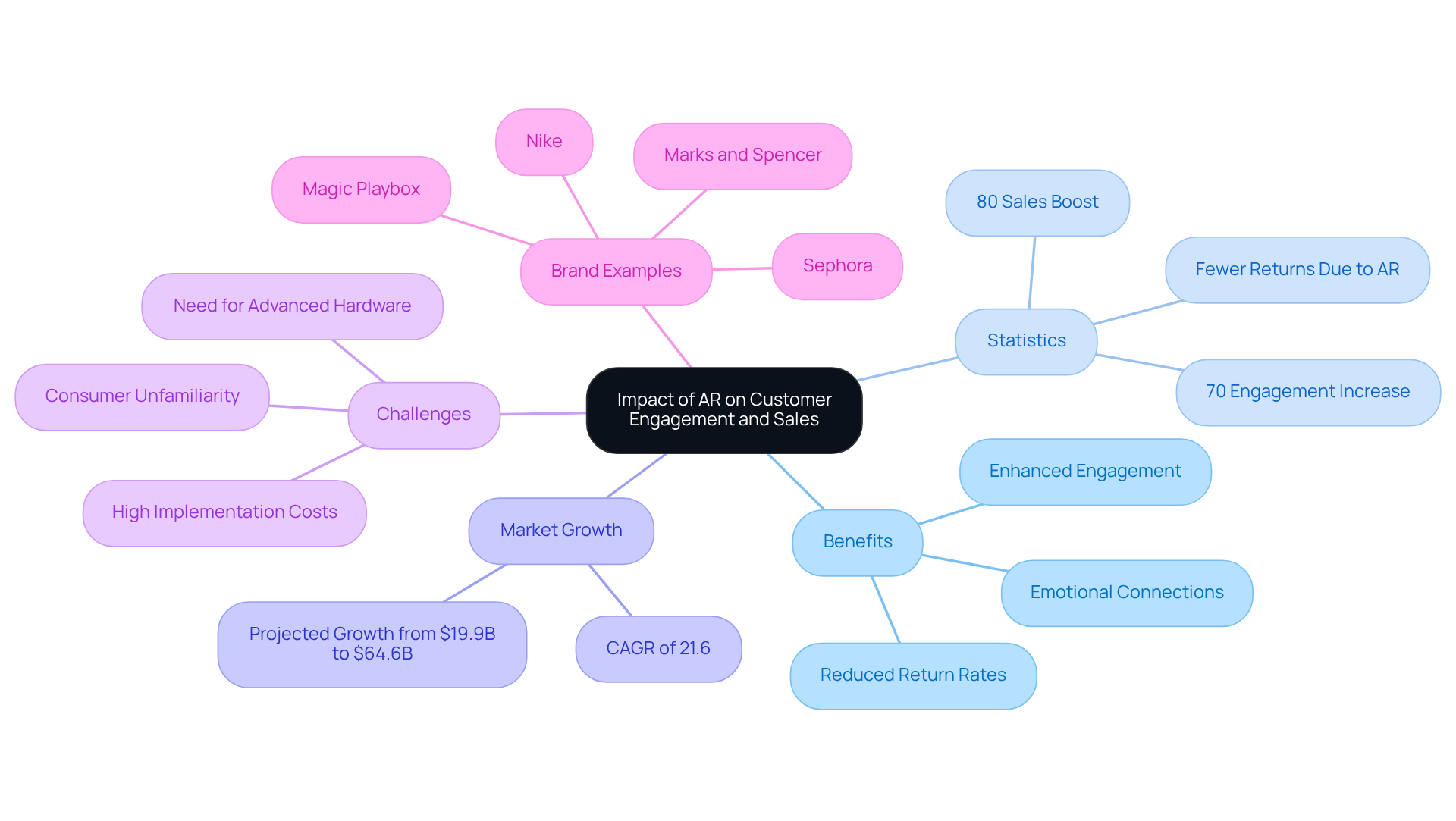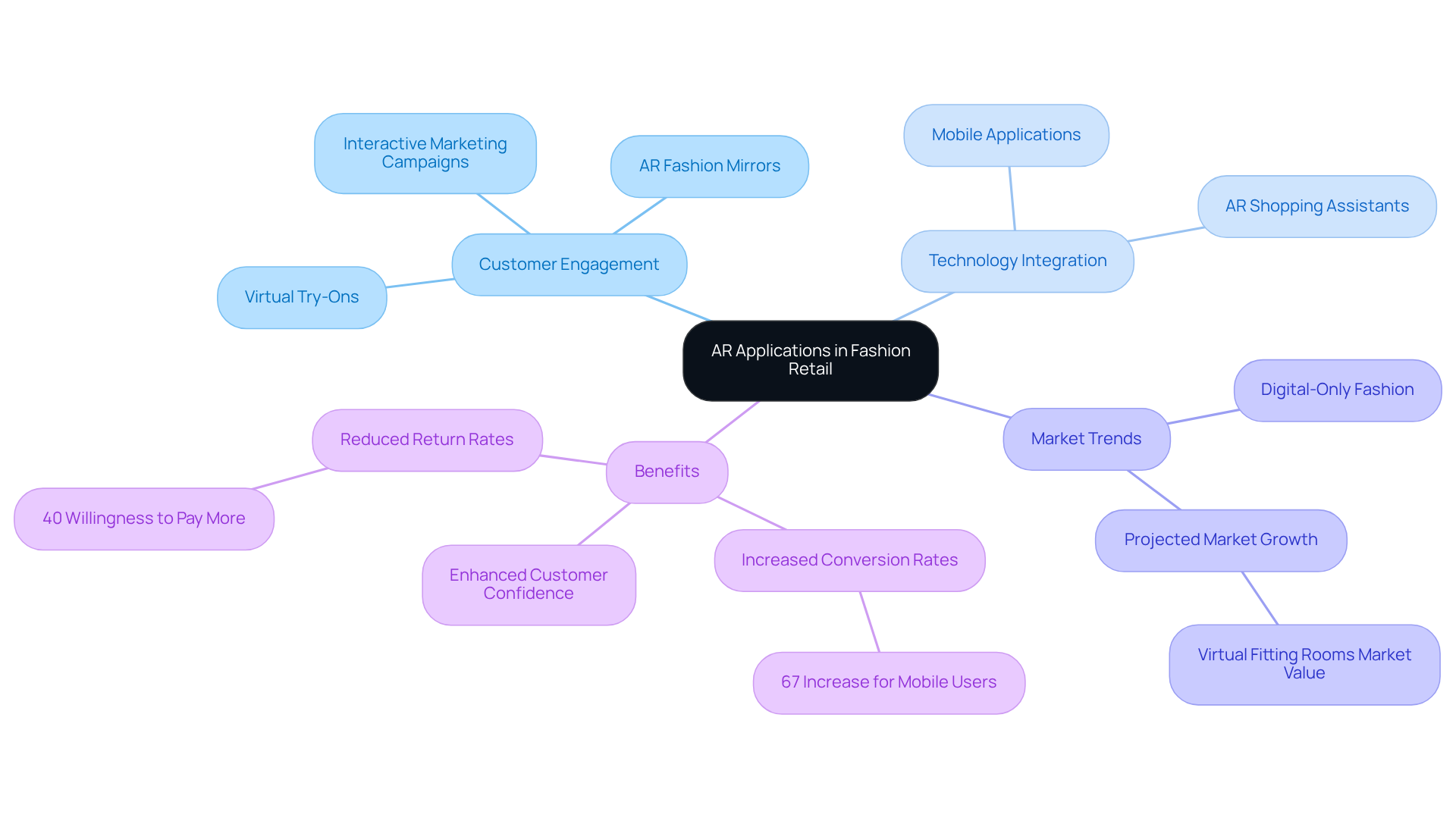Overview
AR fashion represents a groundbreaking fusion of augmented reality technology with the shopping experience, enabling consumers to visualize clothing and accessories in real-time without the need for physical try-ons. This innovative approach not only enhances customer engagement but also drives sales by as much as 80%. Furthermore, it cultivates deeper brand connections, underscoring its transformative influence on the retail fashion landscape. The evidence is clear: embracing AR technology is not just an option; it is essential for brands aiming to thrive in a competitive market.
Introduction
AR fashion is revolutionizing consumer engagement with retail by merging the digital and physical worlds to create immersive shopping experiences. Research indicates that by allowing shoppers to visualize clothing and accessories in real-time, augmented reality not only enhances user engagement but also significantly boosts sales and reduces return rates.
However, as this technology continues to evolve, questions arise about its long-term impact on consumer behavior and the challenges brands face in implementation. What does the future hold for AR fashion, and how will it reshape the retail landscape?
Define Augmented Reality in Fashion
AR fashion revolutionizes the shopping experience by integrating digital elements into real-world interactions, allowing consumers to visualize clothing and accessories in real-time. This technology employs AR fashion to overlay virtual garments onto a user's image, allowing them to assess how items would look and fit without the need for physical try-ons. Applications of AR fashion span from virtual fitting rooms to interactive marketing campaigns, significantly enriching the shopping experience by making it more immersive and personalized. For instance, Canada Goose has successfully implemented AR fashion try-ons for their footwear, allowing shoppers to visualize how boots would perform in various weather scenarios—an innovation shown to reduce return rates by facilitating better purchasing decisions.
Research indicates that AR fashion can elevate sales by up to 80% through enhanced user engagement, particularly among tech-savvy consumers. The integration of AR fashion not only streamlines the shopping experience but also fosters a stronger connection between companies and their clients. Industry leaders recognize this potential; VOGUE and Tmall Luxury, for example, collaborated to launch an online fashion week, enabling shoppers to explore new collections through virtual branded avatars, thereby enhancing engagement and visibility.
As AR fashion technology continues to evolve, its significance in transforming the shopping journey grows, effectively bridging the gap between physical and digital realms. Magic Playbox is at the forefront of this transformation, pioneering immersive AR and XR experiences that bolster company engagement and customer loyalty. This technology is reshaping how individuals interact with AR fashion items, making the shopping experience more captivating and efficient, and ultimately redefining the future of retail.

Explore the Evolution of AR in Retail Fashion
The evolution of AR fashion in retail began in the early 2000s, marking a significant shift in how companies engage with consumers. Initially, AR applications were primarily utilized for marketing campaigns, offering limited interactivity. However, as smartphone technology advanced, fashion labels recognized the potential of AR fashion to enhance user interactions. Key milestones in AR fashion include the introduction of virtual fitting rooms by brands such as Zara, which enable shoppers to visualize outfits without the need for physical try-ons. Furthermore, the implementation of AR fashion mirrors in stores provided an innovative way for shoppers to see how clothing would look on them in real-time.
As AR fashion technology matured, it evolved from basic promotional tools to sophisticated applications that leverage artificial intelligence and machine learning. This evolution has facilitated AR fashion, enabling personalized shopping experiences tailored to individual preferences and body types. For instance, AR-powered product demonstrations have been shown to significantly enhance user engagement. Research indicates that individuals are more likely to make purchases after interacting with AR features. Notably, 34% of users expressed a willingness to use AR fashion while shopping, and 61% prefer stores that offer AR fashion features. The integration of AR fashion is not merely a trend; it represents a fundamental shift in retail, enhancing the way consumers interact with brands and products. Tim Cook, CEO of Apple, has stated that over time, AR features will be as essential as having a website, underscoring the technology's growing importance in the industry.

Analyze the Impact of AR on Customer Engagement and Sales
The impact of AR fashion on client engagement and sales within the fashion sector is substantial. Research indicates that AR interactions can enhance consumer engagement by up to 70%, with 71% of shoppers favoring AR-enabled applications that provide interactive and immersive connections with products. Brands that have adopted AR fashion try-on features—such as Sephora, Nike, and Marks and Spencer—report notable increases in conversion rates and a decrease in return rates, as customers gain confidence in their purchasing decisions. AR technology not only enriches the shopping journey but also fosters emotional connections, resulting in heightened customer loyalty and increased repeat purchases.
Furthermore, statistics reveal that integrating AR fashion can boost sales by up to 80%, with fewer consumers returning items due to AR fashion technologies like virtual try-on, underscoring its potential to transform consumer interactions and drive revenue growth in the competitive fashion landscape. As the market for AR fashion is projected to grow from $19.9 billion in 2024 to $64.6 billion by 2030, the trend toward AR implementation is becoming increasingly essential for companies aiming to enhance client interactions and solidify their market position. Magic Playbox is at the forefront of this transformation, pioneering immersive AR and XR experiences that not only captivate users but also bolster loyalty.
However, challenges such as high implementation costs and consumer unfamiliarity remain critical considerations for companies looking to adopt AR technologies. Addressing these obstacles is vital for leveraging the full potential of AR in driving engagement and sales.

Examine Technological Applications of AR in Fashion Retail
The applications of AR fashion in retail are diverse and rapidly evolving, presenting a significant opportunity for brands to enhance customer engagement. AR fashion solutions stand out as a key innovation, allowing customers to visualize how clothing fits and looks on them directly through their devices. Brands like ASOS and H&M have successfully integrated AR fashion mirrors in their stores, enabling shoppers to see outfits without the need for physical try-ons. This technology not only streamlines the shopping process but also boosts buyer confidence; research indicates that 40% of shoppers are willing to pay extra for products they can test using AR.
Moreover, mobile applications in AR fashion further enhance this interaction by scanning a user's body to provide precise size suggestions, significantly reducing return rates. Retailers utilizing AR fashion through virtual try-ons have reported a remarkable 67% increase in conversion rates among mobile users. Additionally, AR fashion is utilized in interactive marketing campaigns that captivate audiences through gamification and storytelling, creating immersive connections that resonate with today's digital-savvy shoppers.
As AR fashion technology advances, its applications in fashion retail are expected to expand, offering innovative ways for brands to connect with consumers. The integration of AR fashion in e-commerce platforms allows customers to overlay digital clothing and accessories onto their bodies in real time, thereby enhancing the online shopping experience. With the market for virtual fitting rooms projected to reach $5.57 billion by 2024, it is evident that AR fashion is not merely a trend but a transformative force in the fashion industry. Brands must embrace these technologies to stay competitive and meet evolving consumer expectations.

Conclusion
AR fashion is not merely a fleeting trend; it signifies a paradigm shift in consumer engagement with fashion brands. By seamlessly merging the digital and physical realms, augmented reality revolutionizes the shopping experience, allowing customers to visualize products in real-time and make informed purchasing decisions. This integration not only enhances user interaction but also cultivates a deeper connection between brands and their clientele, ultimately redefining the retail landscape.
Throughout this article, we have highlighted key insights, including:
- The evolution of AR in retail
- Its substantial impact on customer engagement and sales
- The diverse applications that enrich the shopping experience
From virtual fitting rooms to interactive marketing campaigns, AR technology elevates consumer confidence and satisfaction, leading to increased conversion rates and reduced return rates. Research indicates that many consumers express a preference for brands that offer AR features, underscoring a clear trend toward immersive shopping experiences.
As the market for AR fashion continues to expand, it is imperative for brands to adopt this technology to remain competitive and meet the evolving expectations of consumers. The potential for AR to drive engagement and sales is immense; however, companies must navigate the challenges of implementation to fully leverage its benefits. By investing in AR solutions, brands can not only captivate their audience but also foster loyalty in an increasingly digital marketplace, paving the way for a future where augmented reality becomes an integral part of the fashion retail experience.
Frequently Asked Questions
What is augmented reality (AR) in fashion?
Augmented reality in fashion revolutionizes the shopping experience by integrating digital elements into real-world interactions, allowing consumers to visualize clothing and accessories in real-time.
How does AR fashion enhance the shopping experience?
AR fashion enhances the shopping experience by overlaying virtual garments onto a user's image, enabling them to assess how items would look and fit without needing physical try-ons.
What are some applications of AR fashion?
Applications of AR fashion include virtual fitting rooms and interactive marketing campaigns, which enrich the shopping experience by making it more immersive and personalized.
Can you provide an example of a brand using AR fashion?
Canada Goose has implemented AR fashion try-ons for their footwear, allowing shoppers to visualize how boots perform in various weather scenarios, which has been shown to reduce return rates.
How does AR fashion impact sales?
Research indicates that AR fashion can elevate sales by up to 80% through enhanced user engagement, particularly among tech-savvy consumers.
What benefits does AR fashion provide to companies?
The integration of AR fashion streamlines the shopping experience and fosters a stronger connection between companies and their clients.
Are there any notable collaborations in the AR fashion space?
Yes, VOGUE and Tmall Luxury collaborated to launch an online fashion week, allowing shoppers to explore new collections through virtual branded avatars, enhancing engagement and visibility.
What is the future of AR fashion technology?
As AR fashion technology evolves, its significance in transforming the shopping journey grows, effectively bridging the gap between physical and digital realms.
Who is leading the innovation in AR fashion experiences?
Magic Playbox is at the forefront of this transformation, pioneering immersive AR and XR experiences that enhance company engagement and customer loyalty.




